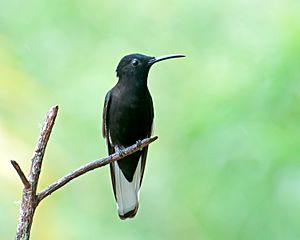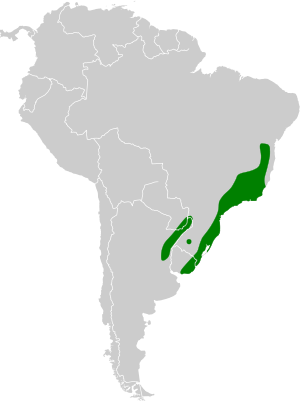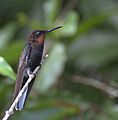Black jacobin facts for kids
The black jacobin (Florisuga fusca) is a beautiful type of hummingbird. It belongs to the bird family called Trochilidae. You can find this special bird in parts of Argentina, Brazil, Paraguay, and Uruguay.
Quick facts for kids Black jacobin |
|
|---|---|
 |
|
| Adult in Reserva Guainumbi, São Luis do Paraitinga, São Paulo, Brazil | |
| Conservation status | |
| Scientific classification | |
 |
|
| Synonyms | |
|
Melanotrochilus fuscus (Vieillot, 1817) |
Contents
About the Black Jacobin
What is Taxonomy?
Scientists group living things based on their shared features. This is called taxonomy. The black jacobin was once thought to be in its own group. But after studying its voice, body, and how it raises its young, scientists moved it. They found it fits better with the white-necked jacobin in the Florisuga group. This means it is the only type of its kind within that group.
What Does it Look Like?
The black jacobin is a small bird. It is about 12 to 13 centimeters (5 inches) long. Males weigh around 9 grams (0.3 ounces). Females are a bit lighter, at about 8 grams (0.28 ounces).
Most of their body is black. Their lower back and the top of their wings are a shiny bronze-olive color. The sides of their body are white. The inner tail feathers are black. The outer tail feathers are white with black tips. Young black jacobins look a bit different. They are dark, but have a wide cinnamon-colored band on their throat. Their belly and outer tail feathers are white.
Where Does it Live?
You can find the black jacobin in southeastern Brazil. Its home range stretches from Bahia south to Rio Grande do Sul. It also lives in eastern Uruguay, southeastern Paraguay, and northeastern Argentina. Sometimes, it is seen in other places too.
This hummingbird prefers forests and woodlands. It also likes gardens and plantations with tall trees. These include coffee and cacao farms. It can live from sea level up to 1,400 meters (4,600 feet) high.
Black Jacobin Behavior
How Does it Move?
The black jacobin is a migratory bird. This means it travels to different places during the year. Scientists are still learning about its exact travel patterns. Generally, it moves south for the cooler months in the Southern Hemisphere. However, some birds have been seen in central Brazil during winter.
What Does it Eat?
The black jacobin looks for food at all levels of its habitat. It mainly sips nectar from flowers. It visits many different native and introduced trees and shrubs. It also feeds from plants called bromeliads.
This bird is very protective of its food. It will chase away other black jacobins and different bird species. But sometimes, many black jacobins gather together. Over 50 birds have been seen feeding on a type of shrub called Dombeya wallichii. Besides nectar, they also catch small insects. They grab them while flying or pick them off leaves and spider webs.
How Does it Breed?
Black jacobins usually breed between July and May. It is common for them to raise two groups of young each year. They build a cup-shaped nest. It is made from thin plant fibers and spiderwebs. They place their nest on a large, flat leaf. This is usually between 1 and 4 meters (3 to 13 feet) high in a tree or bush. A female typically lays two eggs. If a predator comes near, the female will fly in a special way to distract it.
What Sounds Does it Make?
The black jacobin has a unique song. It sounds like a series of high-pitched hissing notes. You might hear "szee..szee....szee..szee..szee....szee..." Its calls include a short "tsik" or "chik." It also makes a short trill sound, like "tr-r-r."
Status of the Black Jacobin
The IUCN (International Union for Conservation of Nature) checks on animals around the world. They have listed the black jacobin as a species of "Least Concern." This means it is not currently in danger of disappearing. Scientists don't know the exact number of black jacobins. They also don't know if their population is growing or shrinking. However, it is common in Brazil. It also lives in many protected areas. Since it can live in places changed by humans, like gardens, losing its habitat is not a big worry.
Images for kids
See also
 In Spanish: Colibrí negro para niños
In Spanish: Colibrí negro para niños



